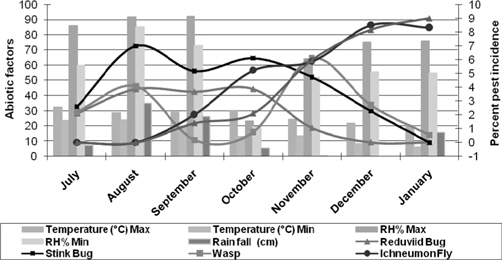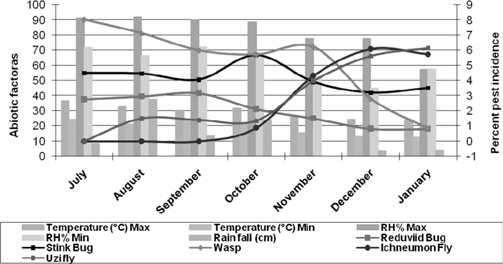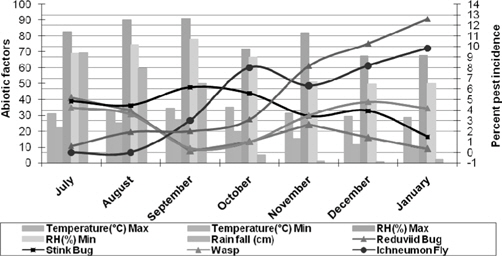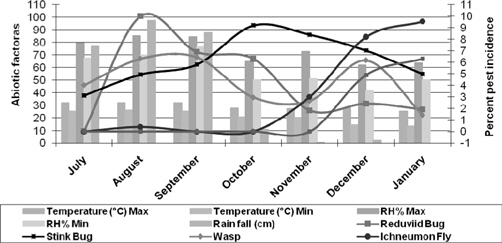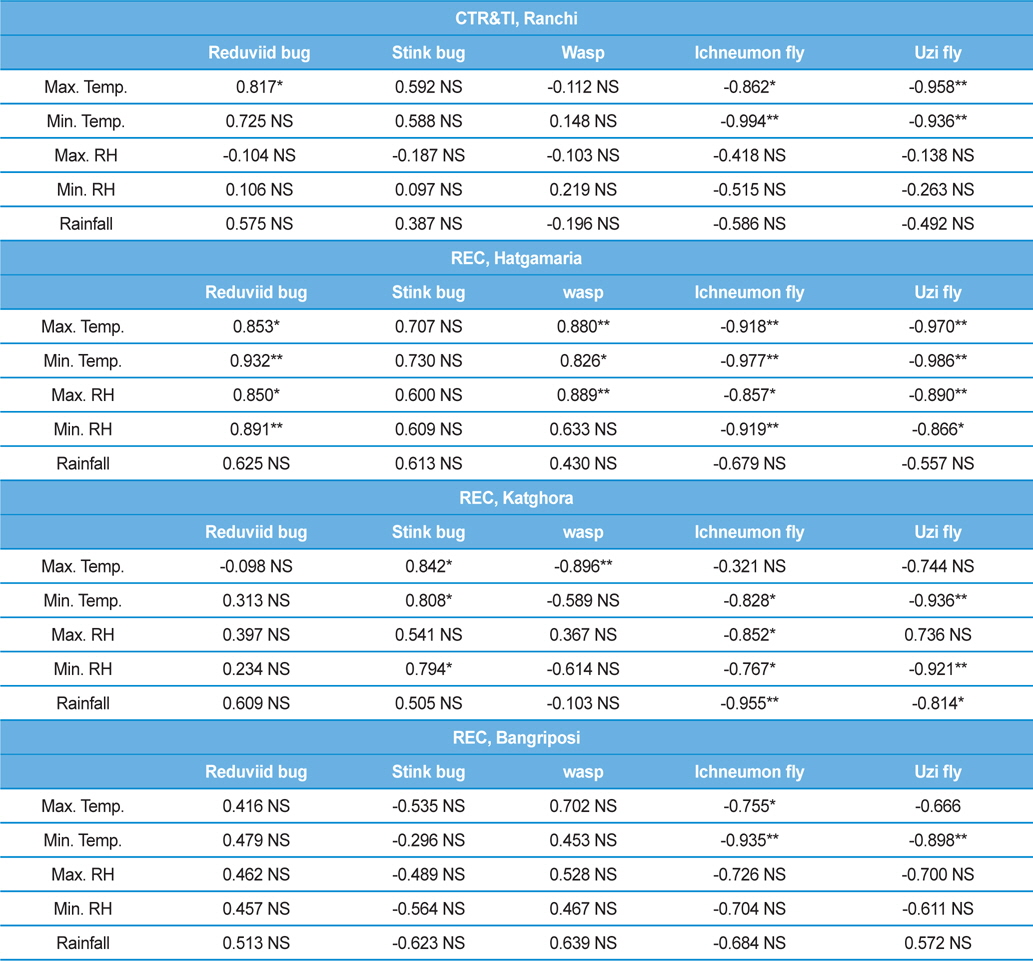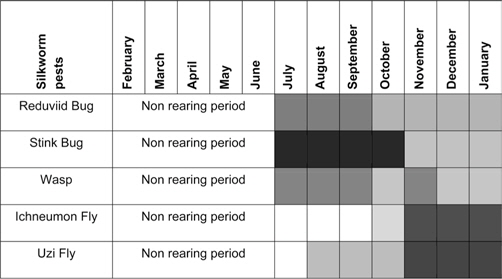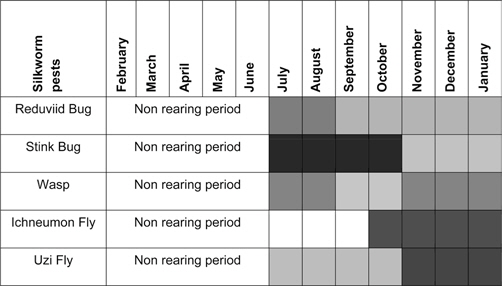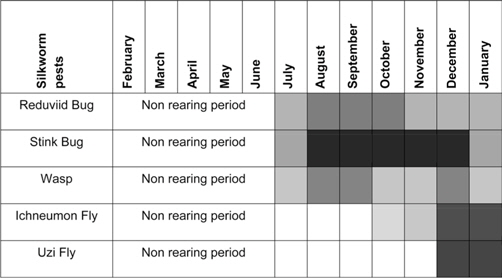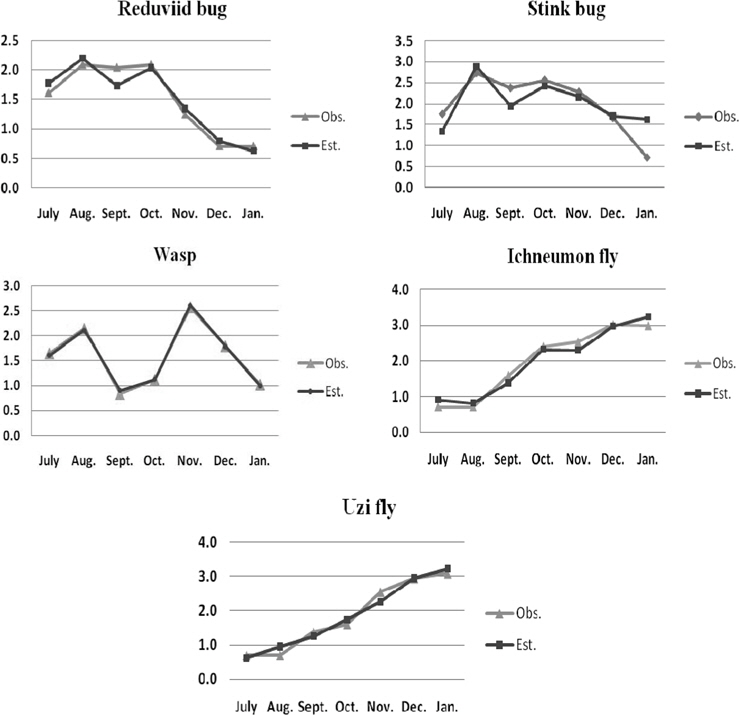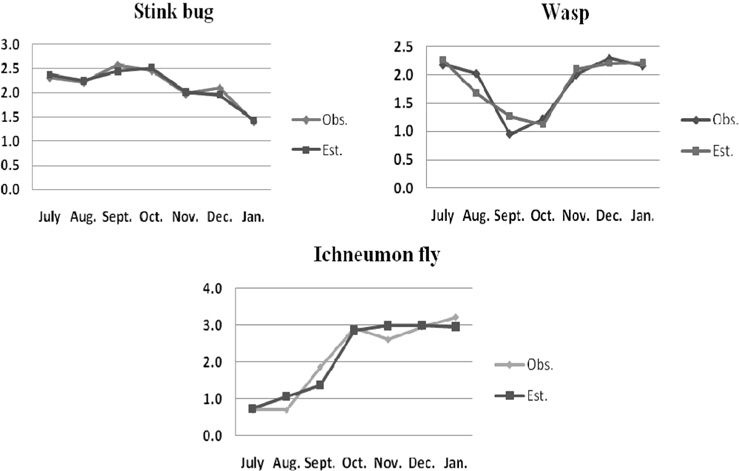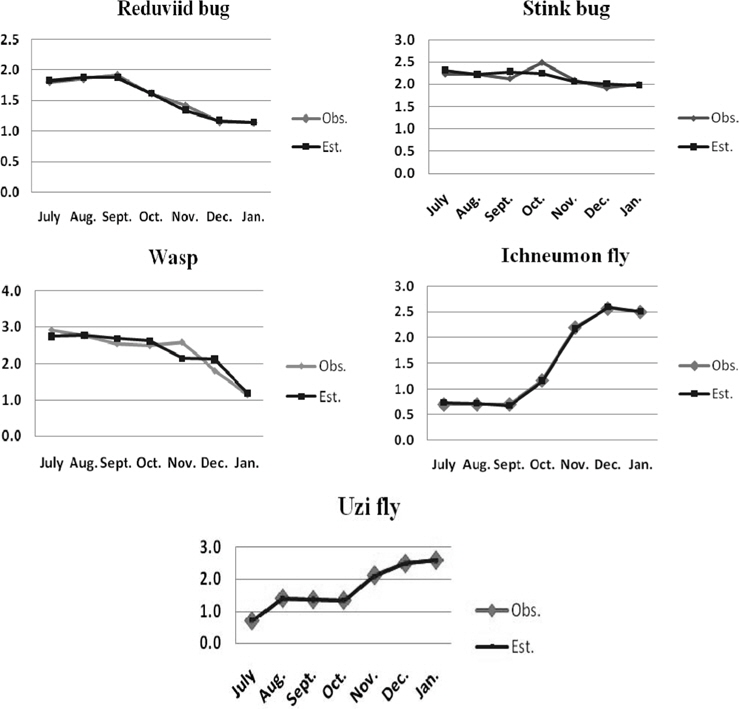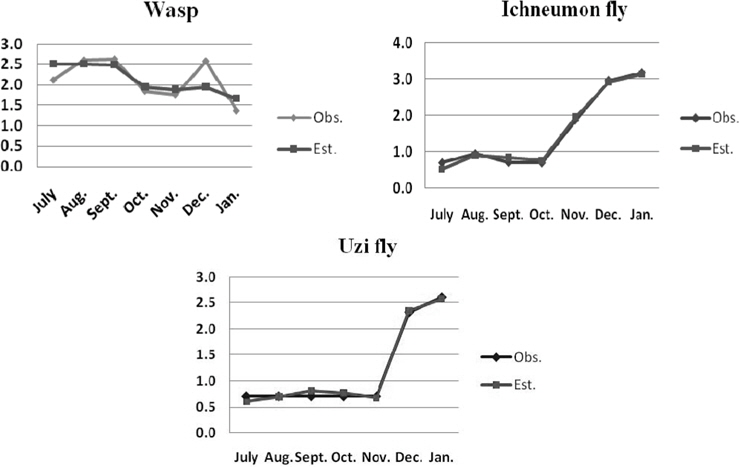



The tasar culture is a cottage, agro-forestry and forestry based industry that provides sustainable livelihood to several rural communities and country to earn foreign exchange. The tasar silk industry generates cocoons through commercial rearings along with the collection from natural habitats by many Indian tribal families as tradition since immemorial.
Abiotic factors alter the survival, development and reproductive capacity of insects. Their activities are mostly dependent on the environmental temperature, prolonged periods of low or high temperatures or sudden change adversely affect the insect development. Similarly humidity and rainfall influence the population of insects (Prasad and Logiswan, 1997). These factors compelled the insects to adapt themselves to the changing climatic conditions or perish (Pedigo, 2004). Among the various physical factors, temperature, humidity and rainfall are considered to be the most important cause of insect population fluctuations.
The pests of tasar silkworm are broadly categoried into predators and parasitoids. Predators cause damage to tasar larvae during early instars and parasitoids during later stages of silkworm rearing. Due to these pests the production of tasar silk is effected considerably.
Keeping in view the above factors, present study was taken up to record the incidence of silkworm pests in different agroclimatic zones to know the influence of abiotic factors on pest prevalence and to prepare a pest calendar as well as to develop prediction model.
Data on prevalence of silkworm pests and predators were collected from 4 different agro-climatic zones of tasar growing areas
>
Prevalence of Pests of silkworm:
The prevalence of major pests of silkworm and abiotic factors at CTR&TI, Ranchi, Jharkhand, REC, Katghora, REC, Hatghmaria and REC, Bangriposi are shown in Fig. 1a − Fig. 1d, respectively. Pest-wise occurrence at different locations and its relation with selected abiotic factors are summarized:
1. Reduviid bug (Sycanus collaris Fabricius)
The peak period of incidence of Reduviid bug was recorded in July and August months in most of the locations. A significant positive correlation between prevalence of Reduviid bug with maximum temperature (r = 0.853*), minimum temperature (r = 0.932**), maximum relative humidity (r =0.850*), and minimum relative humidity (r = 0.891**) was observed at REC, Hatgamaria. At CTRTI, Ranchi the observed correlation between Reduviid bug and maximum temperature (r = 0.817*) was significant and positive.
2. Stink bug (Eocanthecona furcellata Wolf)
The peak period of incidence of Stink bug was recorded in August and November months in most of the locations. A significant positive correlation between prevalence of Stink bug with maximum temperature (r = 0.842*), minimum temperature (r = 0.808*) and minimum relative humidity (r = 0.794*) was found at REC, Katghora.
3. Wasp (Vespa orientalis Linnaeus)
The peak period of incidence of Wasp was recorded in the months of August and November in most of the locations. The correlation was significant and positive between prevalence of Wasp with maximum temperature (r = 0.880**), minimum temperature (r = 0.826*) and maximum relative humidity (r = 0.889**) at REC, Hatgmaria. However, at REC, Katghora the correlation between the pest and maximum temperature (r = -0.896**) was significant and negative.
4. Ichneumon fly (Xanthopimpla pedator Fabricius)
The peak period of Ichneumon fly incidence was observed in the months of November, December and January in most of the locations. The pest showed significant negative correlation with maximum temperature (r = -0.862*, r = -0.755*) and minimum temperature (r = -0.0.994**, r = -0.935**) at CTR&TI, and REC, Bangriposi, respectively. At REC, Hatgamaria the correlation was significant and negative with maximum temperature (r = -0.918**), minimum temperature (r = -0.977**), maximum relative humidity (r = -0.857*) and minimum relative humidity (r = -0.919**). Similarly, the pest exhibited significant negative correlation with minimum temperature (r = - 0.828*), maximum relative humidity (r = -0.852*), minimum relative humidity (r = -0.767*) and rain fall (r = -0.955**).
5. Uzi fly (Blepharipa zebina Walker)
The correlation was significant and negative between uzi fly and the abiotic factors except rain fall at REC, Hatgamaria. The uzi fly showed significant negative correlation with maximum temperature (r = -0.958**) and minimum temperature (r = -0.936**) at CTR&TI, Ranchi and with minimum temperature (r = -0.898**) at REC, Bangriposi. At REC, Katghora the correlation between the pest and minimum temperature (r = -0.936**), minimum relative humidity (r = -0.921**) and rain fall (r= -0.814*) was significant and negative. Correlation coefficients are furnished in Table 2.
[Table 2.] Correlation coefficient between abiotic factors and silkworm pests

Correlation coefficient between abiotic factors and silkworm pests
The data collected from different locations for a period of three years were pooled and the region wise pest calendars were developed for silkworm pests (Figs. 2a − 2d).
The data for biotic and abiotic factors (Table 1) collected from four location namely CTR&TI Ranchi, REC Katghora, REC Hatgamaria and REC, Bangariposi was analyzed to develop the prediction models for silkworm pests using Multiple linear Regression, Yi ( pests) = a + b1 X1 ( Max.Temp.) + b2 X2 (Min.Temp.) + b3 X3 (Max. RH) + b4 X4 (Min. RH) + b5 X5 (Rain fall). Prediction models silkworm pests were worked out using Linear Regression Models (Y = Σ bi Xi + a ) with backward method (SPSS software). The difference was less between estimated and observed values for silkworm pests (Figs. 3-6). The R2 (R-Square) estimate in each model indicates total variation explained by predictive variables in getting the pest incidence. Location wise prediction models for silkworm pests are furnished in Table 3.
[Table 1.] Dependent and Independent variable
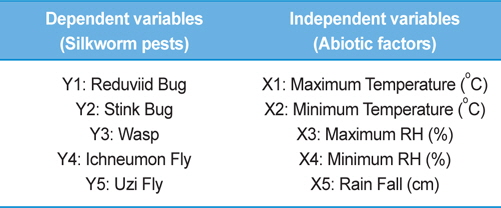
Dependent and Independent variable
[Table 3.] Regionwise Prediction models for Tasar Silkworm Pests
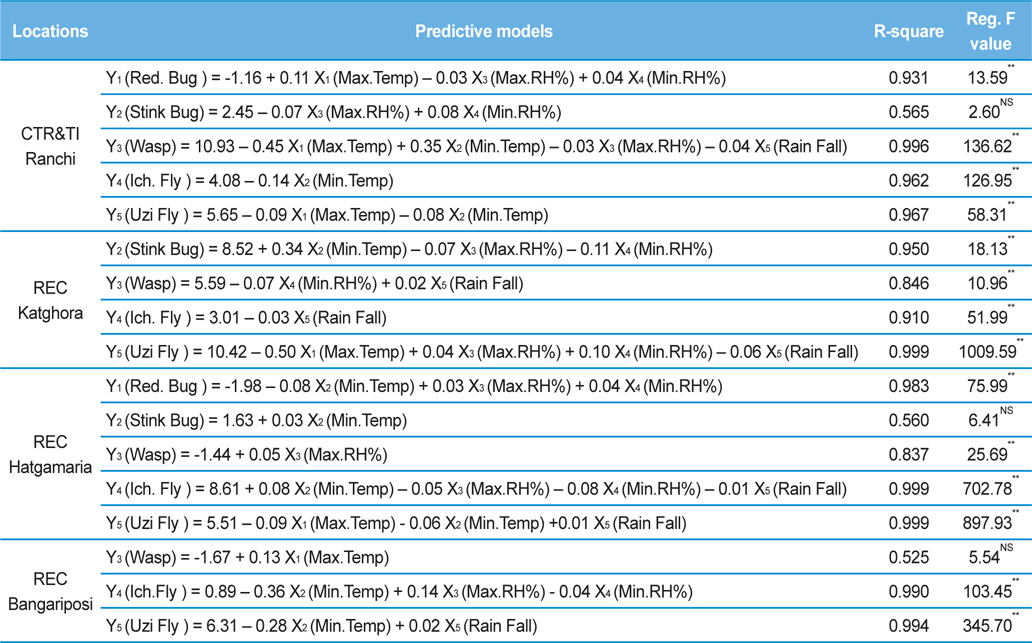
Regionwise Prediction models for Tasar Silkworm Pests
>
Major parasitoids of tasar silkworm
The Uzi fly,
The silkworm larvae infested by uzi fly in early instar die before they reach the spinning stage. If the infestation takes place in the late fifth instar, the mature maggot comes out by piercing the cocoon and thereby rendering the cocoon unfit for mass reeling. Infested silkworm can be identified by the presence of black scar on the part of the skin where the maggot penetrates in to the body of the host larvae. Sometimes, an egg shell is left behind in the centre of the black scar. At the initial stage of infestation minute creamy white oval eggs smaller than pinhead are observed on the skin of the larvae.
The ichneumon fly belongs to the order Hymenoptera, family ichneumonidae. The female fly has nearly 1 cm long prominent needle like ovipositor with two long stylets. The female fly lays eggs inside the pre-pupal body by inserting its ovipositor through freshly formed / flimsy cocoon shell. Only one egg is deposited in each host. The maggot after hatching consumes the entire pupal content except the skin and pupates. The adult fly emerges from the cocoon by piercing the cocoon which renders the cocoon unfit for reeling.
>
Major predators of tasar silkworm
The major predators of silkworm are Stink bug, Reduviid bug, Praying mantis,Wasp and Red ant. The stink bug
On an average single mated female lays 250–350 eggs in batches of 40–70 usually on the under surface of the leaves or on the twigs. Each egg mass consists of four to five rows of 8-15 eggs. The predator lives on the haemolymph of the host, which it sucks by piercing the larval body by its proboscis. It has been observed that single bug can kill 130-225 tasar silkworms of first to third instars throughout its life.
The Reduviid bug,
The Wasp,
Red ants,
In the present study correlation analysis revealed that the abiotic factor showed significant and positive correlation between maximum temperature and reduviid bug at CTR&TI, Ranchi and REC, Hatgamaria. The results are in consonance with the reports of Joshi and Khalid Zafar
The minimum temperature showed significant positive correlation with reduviid bug, wasp and stink bug at REC, Hatgamaria and REC, Katghora, respectively. Significant positive correlation of minimum temperature with Jassid population and Jute semilooper was reported by Iqbal
The maximum and minimum Relative Humidity revealed significant negative correlation with ichneumon fly and uzi fly at REC, Katghora and REC, Hatgamaria. The significant negative correlation between pest and RH is in agreement with the reports of Joshi and Sanjay Kumar (2012), Khalid Zafar
The influence of rain fall was significant and negative between ichneumon fly and uzi fly at REC, Katghora. Similar positive influence of rail fall on pest was reported by Ogah
